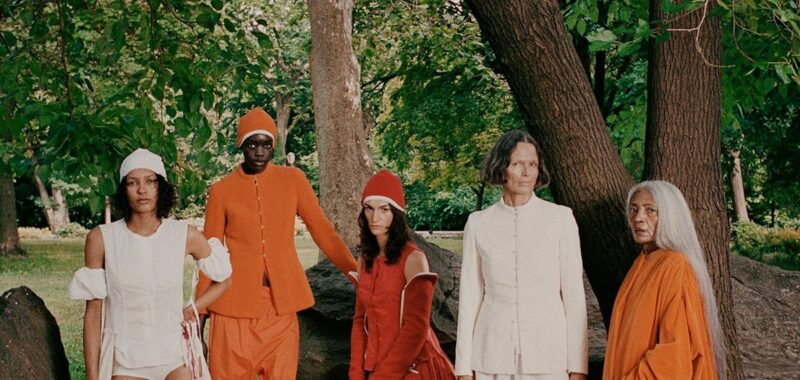Looking back on her initial resistance to creating clothes for women, former menswear designer Colleen Allen laughs. When she was working at The Row, she says, “they asked me to design women’s, and I was like, ‘No, I don’t want to do that!’ I was very rigid. I felt like everything had been said in women’s and there was more to say in men’s. But, eventually, there was an itch at the back of my brain. I realized that there were ideas I wanted to explore.”
Those ideas—identity, spirituality, community—culminated in February in the 28-year-old designer’s New York Fashion Week debut, an imaginatively conceived, tenderly executed exploration of femininity anchored by that often maligned archetype: the witch. It was while she was researching how witches have been portrayed over the centuries, she says, that “something clicked for me.”
Models (from left) MJ Herrera, Ayak Veronica, Serena Wilson, Sylke Golding, and JoAni Johnson wear Colleen Allen clothing and accessories.

Allen, who is now based in Brooklyn, grew up in the suburbs of Chicago. Her grandmother, a quilter, taught her to sew, and weekend classes in illustration and clothing construction—one instructor was Shane Gabier, of Creatures of the Wind—gave her the foundation to seriously pursue becoming a fashion designer. She arrived at Parsons School of Design in 2014 but headed to Central Saint Martins, in London, for what was supposed to be a junior year abroad. She liked it so much that she persuaded the administration to let her stay on. Allen credits the combination of the two schools’ approaches—rigorous technical training at Parsons, and a studio-based format that stresses research and collaboration at Saint Martins—with giving her a solid footing in both design and production.
Three years at The Row further honed these skills. Once she started pondering womenswear, she quit, took on a few freelance design gigs, and began the process of turning her mental catalog of images and thoughts into a coherent statement. An online lecture by the art historian Susan Aberth led her to the tarot deck of the Surrealist artist Leonora Carrington, an English beauty who, in 1937, horrified her straitlaced family by running away to France with the painter and sculptor Max Ernst, who was not only married but also 26 years her elder. Brightly colored and shining with silver and gold leaf, Carrington’s cards, first created in 1955, depict feminine energy that is fecund and irrepressible: Her Empress is Medusa-haired and pregnant; her Hanged Man and the Devil have androgynous features. Carrington based her imagery in part on the practice of witchcraft in Mexico, where she spent most of her life, and on the 19th-century secret society Golden Dawn Order, from which Wicca takes inspiration.
Ayak Veronica wears a Colleen Allen dress and cap.

Allen’s interpretation of the witch is less esoteric and more immediately relevant: a woman who is independent and self-empowered. This translates into clothes that reject the bourgeois stereotypes that have bedeviled fashion recently. There are ruffled pantalettes, which sound jokey but aren’t. The collection’s standout piece is a lightly fitted jacket that resembles an intricately seamed Victorian bodice. It fastens with silver hooks and eyes, a nod to a designer whose work Allen admires: Claire McCardell, who loved the subversive appeal of visible hardware. The ruffled shorts are in cotton, while the jacket is made from polar fleece, a fabric that the forward-looking McCardell, who died in 1958, would surely have embraced. The latter piece was inspired by the garb of storybook witches—call it Salem chic—and by a trip to the Scottish Highlands, where Allen was struck by the disparity between the ancient, epic grandeur of the landscape and her 21st-century hiking gear. Wear the jacket and shorts together, and you have a renegade suit that is both practical and distinctive—and, as Allen puts it, gives you “a warm feeling, like there’s a ritualistic presence as you’re walking around doing your everyday thing.”
Less specifically witchy are an orange velvet cape that falls in deep folds from the shoulder and a magenta wrap-and-tie wool jersey top that swaddles the torso. Both, however, are linked to Allen’s interest in religious rites. Orange is associated with spiritual awareness; think of the robes of Buddhist and Hindu monks. Allen conceived of the top after observing young mothers with their babies bundled tightly against them at a Shinto shrine in Japan. “Being held that way, in a spiritual place, was really powerful,” she says. “Plus, I like having a more personal relationship with your clothes than just when you put something on.”
Ayak Veronica and Golding wear Colleen Allen clothing and accessories.

But it’s the character of the witch that animates this collection, and Allen feels that it’s time to celebrate her power. In Jungian psychology, the witch represents the shadow self, the appetites and instincts that we prefer not to acknowledge: rage, sadness, greed, loneliness. It’s a big concept—but, at its best, fashion takes inarticulate ideas and gives them physical expression. “What you put on has transformative power,” Allen says. “I wanted to access that version of myself—the witch—embody it, and then create that space for other women.” For a designer who once thought she had nothing to say about womenswear, it’s the start of a provocative conversation.
Hair by Junya Nakashima for Oribe at Streeters; Makeup by Marco Castro AMAZONICOIL at Born Artists; Models: Ayak Veronica at New York Models, JoAni Johnson at The 11:14 Agency, MJ Herrera at One Management, Serena Wilson at The Society Management, Sylke Golding at Muse Model Management; Casting by DM Casting; Casting Assistants: Brandon Contreras, Evagria Sergeeva; Produced by Photobomb Productions; Senior Creative Producer: Kevin Warner; Project Manager: Nick Lambrakis; Photo Assistants: Mark Jayson Quines, Ashley McLean; Fashion Assistant: Celeste Roh; Hair Assistants: Christine Moore, Vincent Tobias; Makeup Assistants: Shoko Kodama, Arias Roybal; Tailor: Lindsay Wright; Special Thanks to NYC Park Isham Park & Bruce’s Garden.

